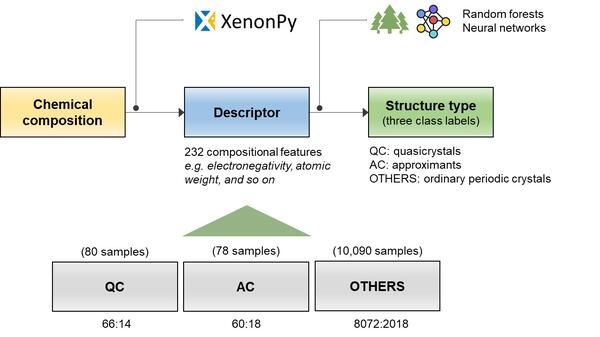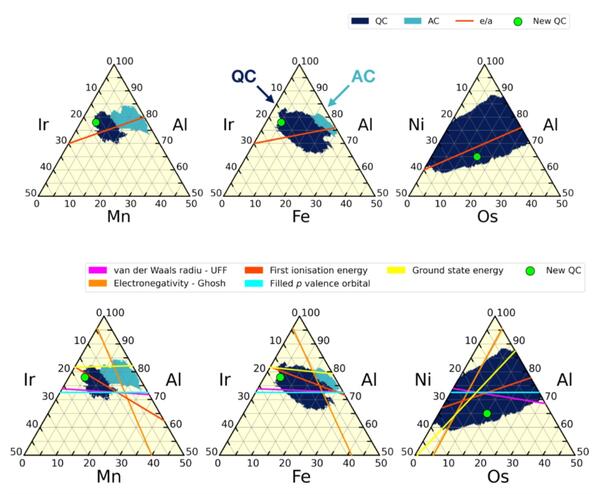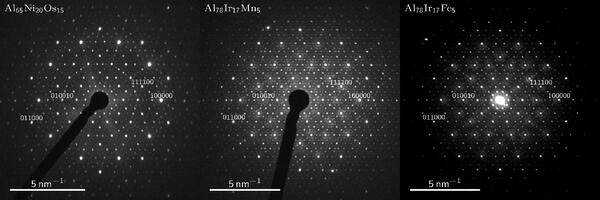First Quasicrystal Discovered by Machine Learning Algorithm
ISM2023-05
September 28, 2023
|
Quasicrystals are materials that do not have the translational symmetry of ordinary crystals, but have a high degree of order in their atomic arrangement. Since the first quasicrystal was discovered in 1984, approximately 100 thermally stable quasicrystals have been discovered. The discovery of new quasicrystals has led to the discovery of physical properties unique to quasiperiodic structures and new developments in materials science to unravel their mysteries. However, the mechanisms of quasicrystal formation and stabilization are still largely unknown, making the search for new quasicrystals extremely difficult. A research group of the Institute of Statistical Mathematics, Tokyo University of Science, and the University of Tokyo has successfully developed a machine learning algorithm to predict the chemical compositions that form thermally stable quasicrystals by learning the patterns of quasicrystals and related materials that have been synthesized to date. Based on the machine learning predictions, the group discovered three new quasicrystals (Al65Ni20Os15, Al78Ir17Mn5, and Al78Ir17Fe5). These are the first quasicrystals discovered by machine learning algorithms in the 40-year history of quasicrystal research. The paper was published online in Physical Review Materials on September 25, 2023. |
Background
Since the discovery of the first quasicrystal1) by Dr. Dan Shechtman (Nobel Prize in Chemistry 2011) of the Israel Institute of Technology in 1984, approximately 100 thermally stable quasicrystals have been discovered. The Al-Mn icosahedral quasicrystal discovered by Dr. Shechtman was a metastable alloy synthesized by rapid melt cooling, which led to low structural order and controversy over the existence of quasiperiodic materials. Soon after, Dr. Tsai, An-Pang (1958-2019), then a doctoral student at the Institute for Materials Research, Tohoku University, and later a professor at the Institute of Multidisciplinary Research for Advanced Materials, Tohoku University, succeeded in synthesizing stable and high-quality quasicrystals, putting an end to this debate. Since then, Dr. Tsai and his colleagues have successively discovered stable quasicrystals and made dramatic progress in the analysis of their structures and physical properties, thus laying the foundation for the current quasicrystal research. It is said that about 90% of the quasicrystals that exist today are derived from the series of materials discovered by Dr. Tsai and his colleagues.The discovery of new quasicrystals has revealed new physical phenomena such as anomalous electronic properties, insulator-like behavior, valence fluctuations, quantum criticality, superconductivity and ferromagnetism. From the analysis of these physical phenomena, the mechanism derived from the long-range quasi-periodic order is being clarified. On the other hand, there are still vast unexplored regions in the material space, where researchers expect to find semiconductor quasicrystals and antiferromagnetically ordered quasicrystals that have not yet been discovered. Dr. Tsai has also stressed the importance of the search for new materials in the development of materials science. However, the mechanisms of quasicrystal formation and stabilization are still largely unknown, and the lack of design guidelines for the search for new materials has severely hampered the progress in quasicrystal research.
Research Details and Results
The research group therefore introduced machine learning to accelerate the process of quasicrystal discovery (Figure 1
). The input to the prediction model is the chemical composition and the output is a class label indicating whether or not the resulting material forms a quasicrystal. As a training dataset, the researchers used chemical compositions of previously synthesized quasicrystals, related materials, and ordinary periodic crystals. The model was found to be able to predict the binary classification task of quasicrystal or not with greater than 95% accuracy.
Interestingly, the trained model was found to autonomously learn the Hume-Rothery electron concentration rule, an empirical rule that Dr. Tsai had used to guide his search for new materials. It is known that the average number of itinerant electrons per atom2) e/a takes a specific value for many chemical compositions in which the quasicrystals are thermally stabilized. For example, the locations of the quasicrystalline phases predicted by the model were found to overlap with the region where e/a = 1.8 in most aluminum alloys. In other words, the machine learning algorithm was learning from the patterns of quasicrystal compositions that Dr. Tsai and his colleagues had discovered, the empirical rules that were the key driver of Dr. Tsai's serendipity. Dr. Tsai passed away on May 25, 2019, at the age of 60, and the global quasicrystal community is deeply saddened. The research group decided to name this model TSAI, with the hope of creating an artificial intelligence (AI) that mimics Dr. Tsai's serendipity. The research group also identified five laws of quasicrystal formation by extracting the input-output rules inherent in the black-box model of machine learning. These rules are expressed by five simple mathematical equations regarding the van der Waals radius and electronegativity of constituent atoms. The rule of TSAI may provide a new guideline for the search for new quasicrystals.
In this study, TSAI was used to perform an exhaustive screening of 1,080 alloy systems, which corresponds to the entire space of aluminum ternary alloys. As a result, quasicrystalline phases were predicted to exist in 185 alloy systems. From these, the researchers excluded those for which phase diagrams had been reported in previous studies, and finally narrowed the list down to 30 candidates. As a first attempt, Al-Ni-Os, Al-Ir-Mn, and Al-Ir-Fe were selected, and synthesis experiments revealed the presence of quasicrystalline phases (Al65Ni20Os15, Al78Ir17Mn5, and Al78Ir17Fe5) in all systems. As shown in Figure 2
, the predicted phase diagrams for Al-Ni-Os, Al-Ir-Mn, and Al-Ir-Fe are spot-on for the three discovered quasicrystals. These quasicrystals were also found to be located near the confluence of the lines representing the Hume-Rothery rule and the five formation rules discovered by TSAI. All three quasicrystals were observed after a long annealing process, suggesting that they are thermodynamically stable materials. In addition, electron diffraction patterns taken using a transmission electron microscope revealed that all three materials have decagonal quasicrystal structures (Figure 3
).
Actions Going Forward
This study is a milestone in proving that machine learning can predict new quasicrystals. The three quasicrystals synthesized are the first materials predicted and discovered by machine learning algorithms in the 40-year history of quasicrystal research. Many researchers are currently using TSAI to synthesize new quasicrystals, and many new materials are expected to be discovered in the future. In particular, the researchers hope that machine learning will contribute to the discovery of semiconductor quasicrystals, antiferromagnetic quasicrystals, and other innovative materials that have not yet been explored by mankind. The research group has also released the code and training data in order to validate the model through further empirical studies and to promote further development of machine learning technologies in quasicrystal research.
|
|
| Figure 1: Machine learning to predict chemical compositions that form quasicrystals |
|
|
| Figure 2: Predicted phase diagram from machine learning and the three aluminum alloy quasicrystals discovered. Dark blue represents the predicted quasicrystalline phases and light blue represents the phase of approximant crystals. The green dots denote the three synthesized quasicrystals. The upper panel represents straight lines satisfying the Hume-Rothery rule e/a=1.8. The middle panel represents the five rules discovered by the artificial intelligence TSAI. |
| Figure 3: Electron diffraction patterns of the three discovered quasicrystals (Al65Ni20Os15, Al78Ir17Mn5, and Al78Ir17Fe5) |
Paper published
Title: Quasicrystals predicted and discovered by machine learning
Authors: Chang Liu, Koichi Kitahara, Asuka Ishikawa, Takanobu Hiroto, Alok Singh, Erina Fujita, Yukari Katsura, Yuki Inada, Ryuji Tamura, Kaoru Kimura, Ryo Yoshida
Journal: Physical Review Materials
DOI: 10.1103/PhysRevMaterials.7.093805
Publication date: September 25, 2023 (electronic version)
Acknowledgements
This work was supported by MEXT KAKENHI Grant-in-Aid for Scientific Research on Innovative Areas with Grant Number 19H05817, 19H05818, 19H05820, JST-CREST with Grant Number JPMJCR22O3, Grant-in-Aid for Scientific Research (A) 19H01132 from the Japan Society for the Promotion of Science (JSPS).
| Contact |
|
[News, public relations] |
プレスリリース
- ISM2014-01
- ISM2014-02
- ISM2014-03
- ISM2014-04
- ISM2014-05
- ISM2014-06
- ISM2015-01
- ISM2015-02
- ISM2015-03
- ISM2015-04
- ISM2016-01
- ISM2016-02
- ISM2016-03
- ISM2016-04
- ISM2016-05
- ISM2016-06
- ISM2016-06_e
- ISM2016-07
- ISM2016-08
- ISM2016-09
- ISM2016-10
- ISM2017-01
- ISM2017-02
- ISM2017-03
- ISM2017-04
- ISM2017-05
- ISM2018-01
- ISM2018-02
- ISM2018-03
- ISM2018-04
- ISM2018-05
- ISM2018-05_e
- ISM2018-06
- ISM2018-07
- ISM2018-08
- ISM2019-01
- ISM2019-02
- ISM2019-03
- ISM2019-04
- ISM2019-05
- ISM2019-06
- ISM2019-07
- ISM2019-07_e
- ISM2019-08
- ISM2019-08_e
- ISM2019-09
- ISM2020-01
- ISM2020-02
- ISM2020-03
- ISM2020-04
- ISM2020-05
- ISM2020-06
- ISM2020-06_e
- ISM2020-07
- ISM2020-08
- ISM2020-09
- ISM2020-10
- ISM2020-11
- ISM2020-12
- ISM2021-01
- ISM2021-02
- ISM2021-02_e
- ISM2021-03
- ISM2021-04
- ISM2021-05
- ISM2021-06
- ISM2021-06_e
- ISM2021-07
- ISM2021-07_e
- ISM2021-08
- ISM2021-09
- ISM2021-10
- ISM2022-01
- ISM2022-02
- ISM2022-03
- ISM2022-03_e
- ISM2022-04
- ISM2022-05
- ISM2022-05_e
- ISM2022-06
- ISM2022-07
- ISM2022-08
- ISM2022-08_e
- ISM2023-01
- ISM2023-02
- ISM2023-03
- ISM2023-03_e
- ISM2023-04
- ISM2023-05
- ISM2023-05_e






